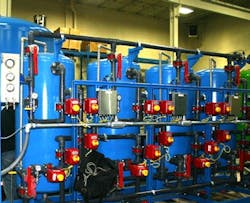Dewatering for Iron and Manganese Removal
undefinedImplementing the Treatment System
Measuring Results
The model GAC-4260CS-2-MVH utilizes AdEdge GAC (granular activated carbon) in a two-vessel carbon steel configuration in series. Each 42-in. carbon steel vessel contains 30 cu ft of GAC for polishing the water prior to discharge to the sanitary sewer.
In October 2010, AdEdge Water Technologies LLC was contacted by JVA Inc. to provide an iron and manganese dewatering system for residences in Boulder, Colo.
Raw groundwater contained iron levels between 4.6 and 7.4 mg/L and a manganese level of 4.5 mg/L, well above the U.S. Environmental Protection Agency (EPA) secondary maximum contaminant levels (MCL) of 0.3 mg/L and 0.05 mg/L respectively. Iron and manganese levels need to comply with the EPA MCLs in order to discharge into the sanitary sewer and meet applicable discharge criteria.
